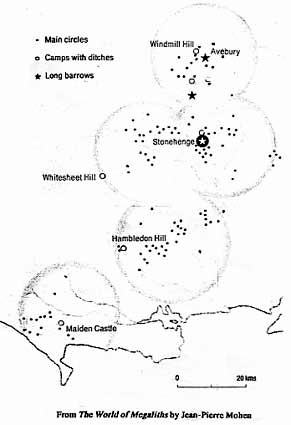TERRITORIES
IN WESSEX 2000 BC
The Prehistoric
monuments near Stonehenge lie in five regularly spaced groups
representing the three main styles of construction: long barrow,
camp with circular ditch, and large ring of standing stones.
All lie in open limestone country between wooded clay banks,
and accurately mirror the patterns of settlement around 2000
B.C. in an area covering no more than about 100 kilometres at
any point.

Each of
the five concentrations is known as a ‘territory’,
about 20 kilometres across. Each contained between 3000 and
8000 individuals under the leadership of one family who arranged
the construction of the largest funerary monuments. Were there
any links between political and military powers, under this
divided system? The central site of Stonehenge, whose construction
demanded considerable numbers of workers, can be seen as a symbol
of the unifying strength of a very powerful price. The single
tomb under the mound of Bush Barrow, built near Stonehenge at
the beginning of the Bronze Age, may mark the grave of one of
these important individuals, buried with his treasure and his
sceptre. At Stonehenge the divisions between temporal and religious
powers may have been blurred. The isolation of ceremonial sites
such as the great circles of standing stones, the complexity
of initiatory knowledge based on celestial observation –
everything seems to indicate that the two sources of power were
separate, even if religious faith depended on the protection
of temporal strength.
 |
 |
Megalithic
Structures Index
|